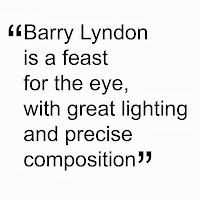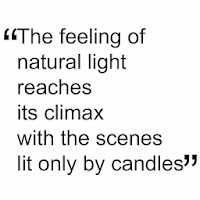Barry Lyndon didn't receive a big commercial success when it was released back in 1975. But now it is considered one of Kubrick's finest film. It is a film on a grand scale which abounds in meticulous technical craftsmanship and it owes its success to Kubrick, of course, but also to cinematographer John Alcott and electronic engineer Ed DiGiulio.
The Plot. Barry Lyndon is a slightly thick, hungrily ambitious young Irishman who longs tu pull himself up by his low-born origin into the superficial and illusory world of the nobility, and he almost succeeds in doing it.
Camera: Arriflex 35BL, Mitchell BNC
Lenses: Canon K35, Zeiss ƒ 0.7, Angenieux 25-250
Aspect ratio: 1.66:1
Format: 35mm
Film Stock: Kodak Eastman 5254 100T
John Alcott already worked with Kubrick as cinematographer in his previous works (2001: A Space Odyssey and A Clockwork Orange), he was actually promoted by Kubrick during the shooting of 2001; but saying that Barry Lyndon's cinematography is Alcott's job would not be right. It is instead a close collaboration between Alcott and Kubrick, who was a fine photographer himself. The result is a delicious feast for the eye, where each composition is like a painting by one of the old Master.
They actually studied and searched for lots of references in the paintings of the Dutch Masters but they seemed to them to be a bit flat so they decided to light the scenes a bit more from the side. Anyway, they went after a pictorial style with a soft and subtle rendition of light and shadows.
 John Alcott used to define himself as a natural light cameraman: he managed to master light to naturally light the scene in all of the features he DP'd and, of course, Barry Lyndon is no exception; in fact it was the first historical film to be lit in a natural way: lighting in a more theatrical way was the trend at that time for that kind of features. Throughout Barry Lyndon, there's a constant feeling of natural light coming through the windows of the locations simulated by Mini-Bruts always placed outside the houses where they shot. Anyway, there are some scenes, like the one with Barry and Captain Potzodof, lit with light placed on top of their head which is no really justified nor natural.
John Alcott used to define himself as a natural light cameraman: he managed to master light to naturally light the scene in all of the features he DP'd and, of course, Barry Lyndon is no exception; in fact it was the first historical film to be lit in a natural way: lighting in a more theatrical way was the trend at that time for that kind of features. Throughout Barry Lyndon, there's a constant feeling of natural light coming through the windows of the locations simulated by Mini-Bruts always placed outside the houses where they shot. Anyway, there are some scenes, like the one with Barry and Captain Potzodof, lit with light placed on top of their head which is no really justified nor natural.
They had to gel windows and use different ND to stop down the light and, despite the "rules", they never used a 85 filter to colour correct the light to give an overall consistent balance throughout the film and because of the low light conditions of exterior light they had to deal with sometimes: in this way they managed to keep the extra 2/3 of a stop the filter would have taken down.
Shooting exteriors was a problem because the brightness of the day changed a lot so they had to change the aperture constantly to match the brilliance (not always achieving it thou), finding themselves to shoot with full aperture: the Canon K35 T1.2 come quite helpful in several shots.
Instead of using diffusion filters, quite trendy at that time, Alcott and Kubrick decided to use Low Contrast Filter which is not really consistent throughout the entire picture but doesn't affect the overall cinematography. In the wedding sequence we notice the use of the filter combined with a brown net which gave Alcott a more control over the highlights. Another filter Alcott used unconventionally is the Graduated Neutral Density filters, making use of them for interior shots (Was he probably the first one to do so?).
Another interesting technique used by Alcott is the use of mixed coloured light during the film. In the scene of Barry's room after he has had his leg amputated, for example, a warm effect is achieved by placing 1/2 sepia gel over the light coming through the window. While, when Barry's boy is dying, the natural blue day-light comes trough the window without colour correction.
Camera movements are used in certain sequences but without making an excessive use of them, like travellings and handheld camera for the scenes of the battle. But the use of the Angenieux zoom is always preferred, zooming in to close ups from very wide shots in a voyeuristic manner, and the other way round, opening from a close up to reveal the whole scene. The zoom was used along with travelling too, like the scene of the battle, where a very long travelling is used and the zoom starts at 250mm with a close up.
 But, the most interesting and probably most technically difficult scenes to shoot were definitely the candle lights scenes. The naturalism in the way of lighting reaches its extreme because no natural light was used whatsoever: the scenes are lit exclusively by candles, which was something technically impossible given the available means of those years. But Kubrick's stubbornness and Ed DiGiulio's expertise made history. Kubrick discovered some Zeiss lenses which were designed for the Hasselblad NASA took to the expedition to the Moon and which had a maximum aperture of ƒ 0.7. DiGiulio made the necessary adjustments to fit the Mitchell camera.
But, the most interesting and probably most technically difficult scenes to shoot were definitely the candle lights scenes. The naturalism in the way of lighting reaches its extreme because no natural light was used whatsoever: the scenes are lit exclusively by candles, which was something technically impossible given the available means of those years. But Kubrick's stubbornness and Ed DiGiulio's expertise made history. Kubrick discovered some Zeiss lenses which were designed for the Hasselblad NASA took to the expedition to the Moon and which had a maximum aperture of ƒ 0.7. DiGiulio made the necessary adjustments to fit the Mitchell camera.
They placed candles all around the scene and used a 70 candles chandelier with metal reflectors attached to the ceiling bouncing light down. The had lots of trouble with focus because of the very shallow depth of field and the impossibility of checking on a viewfinder due to loss of luminance, but the result is superb.
Barry Lyndon is a marvellous film, the composition of every scene is perfect and precise, one of the great and emblematic Kubrick's characteristic, and its cinematography is beautiful and innovative, and, even if more than 35 years have passed, today it keeps on being a reference for every photographer or cinematographer.
No comments:
Post a Comment